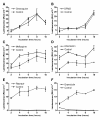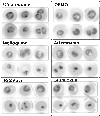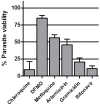ATP and luciferase assays to determine the rate of drug action in in vitro cultures of Plasmodium falciparum
- PMID: 23134617
- PMCID: PMC3505462
- DOI: 10.1186/1475-2875-11-369
ATP and luciferase assays to determine the rate of drug action in in vitro cultures of Plasmodium falciparum
Abstract
Background: Knowledge of the rate of action of compounds against cultured malaria parasites is required to determine the optimal time-points for drug mode of action studies, as well as to predict likely in vivo parasite clearance rates in order to select optimal hit compounds for further development. In this study, changes in parasite ATP levels and transgenic luciferase reporter activity were explored as means to detect drug-induced stress in cultured parasites.
Methods: In vitro cultures of Plasmodium falciparum 3D7 wild-type or firefly luciferase-expressing parasites were incubated with a panel of six anti-malarial compounds for 10 hours and parasite ATP levels or luciferase activity determined at two-hour intervals using luminescence-based reagents. For comparative purposes, parasite morphology changes were evaluated by light microscopy, as well as the extent to which parasites recover after 48 hours from a six-hour drug treatment using a parasite lactate dehydrogenase assay.
Results: Changes in parasite ATP levels displayed three phenotypes: mild or no change (chloroquine, DFMO); 2-4 fold increase (mefloquine, artemisinin); severe depletion (ritonavir, gramicidin). The respective phenotypes and the rate at which they manifested correlated closely with the extent to which parasites recovered from a six-hour drug treatment (with the exception of chloroquine) and the appearance and severity of morphological changes observed by light microscopy. Luciferase activity decreased profoundly in parasites treated with mefloquine, artemisinin and ritonavir (34-67% decrease in 2 hours), while chloroquine and DFMO produced only mild changes over 10 hours. Gramicidin yielded intermediate decreases in luciferase activity.
Conclusions: ATP levels and luciferase activity respond rapidly to incubation with anti-malarial drugs and provide quantitative read-outs to detect the appearance and magnitude of drug-induced stress in cultured parasites. The correlation between the observed changes and irreversible parasite toxicity is not yet sufficiently clear to predict clinical clearance rates, but may be useful for ranking compounds against each other and standard drugs vis-à-vis rate of action and for determining early time-points for drug mode of action studies.
Figures





References
-
- Dharia NV, Chatterjee A, Winzeler EA. Genomics and systems biology in malaria drug discovery. Curr Opin Investig Drugs. 2010;11:131–138. - PubMed
Publication types
MeSH terms
Substances
LinkOut - more resources
Full Text Sources

